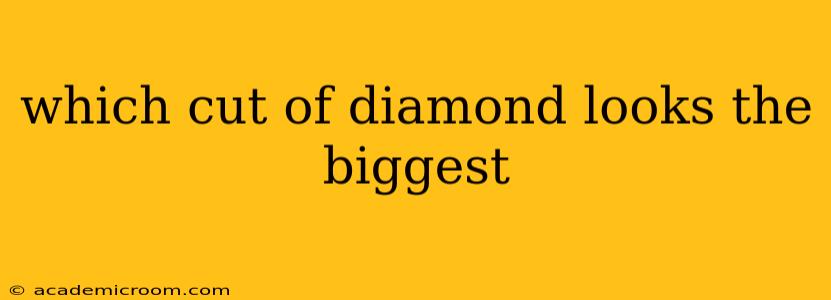Which Cut of Diamond Looks the Biggest?
Choosing a diamond is a significant decision, and one of the crucial factors many consider is how large the stone appears. While carat weight measures the diamond's actual size, the cut significantly influences how big it looks. The cut, in essence, dictates how well a diamond interacts with light, influencing its brilliance, fire, and scintillation, all of which contribute to its perceived size. So, which cut makes a diamond appear largest? The answer isn't straightforward, but we can explore the key factors.
What is the most important factor in making a diamond look bigger?
The most significant factor determining a diamond's apparent size isn't the cut alone, but rather the combination of cut and carat weight. A well-cut diamond, regardless of its specific shape, will generally appear larger than a poorly cut diamond of the same carat weight. This is because a superior cut maximizes light return, creating more sparkle and brilliance, which makes the stone seem more substantial.
Does the round brilliant cut always look the biggest?
While the round brilliant cut is often perceived as the classic and most sparkly, it doesn't automatically mean it always looks the biggest. While its symmetrical design and multiple facets are optimized for light performance, other cuts can visually compete in size, particularly when considering proportions and depth. A poorly cut round brilliant will appear smaller and less brilliant than a well-cut diamond of a different shape.
How does the shape of the diamond affect its perceived size?
Different diamond shapes have different proportions, and these proportions can significantly impact the perceived size. For example:
- Princess cut: Princess-cut diamonds, with their sharp corners and relatively shallow depth, can sometimes appear larger than round brilliants of the same carat weight. However, this is highly dependent on the quality of the cut.
- Emerald cut: Emerald cut diamonds, known for their long, clean lines and step cuts, may appear slightly smaller than round brilliants due to their table's larger size and shallower depth. But, the step cuts give a very elegant and classic look.
- Oval cut: Oval cuts tend to visually elongate the finger, making the stone appear larger, while maintaining a good amount of sparkle.
- Pear cut: Pear cuts, with their unique teardrop shape, can also appear larger than their carat weight suggests, due to their length.
Which diamond cut maximizes brilliance and therefore perceived size?
A well-cut diamond, regardless of its shape, will always look bigger than a poorly cut diamond of the same weight. A superior cut ensures that light is reflected back to the eye efficiently, creating more sparkle and the illusion of greater size. This is why focusing on the "excellent" or "ideal" cut grades is paramount, regardless of the specific shape. Look for diamonds with excellent symmetry, polish, and proportions.
How can I make a smaller diamond appear larger?
Besides choosing a well-cut diamond, there are other techniques to make a smaller diamond appear larger:
- Setting: The setting significantly influences how a diamond looks. A simple, low-profile setting will make the diamond seem larger than a bulky or ornate setting.
- Color: A colorless diamond (or one with very slight color) will appear larger than a yellowish or brownish diamond because the color can diminish brilliance and thus the perceived size.
- Clarity: While clarity doesn't directly impact perceived size, inclusions (internal flaws) can sometimes obscure light, making a diamond appear smaller. However, a well-cut diamond will minimize the visual impact of minor inclusions.
In conclusion, while a specific cut doesn't guarantee the biggest appearance, choosing a well-cut diamond of any shape, paying attention to the aforementioned factors (setting, color, clarity), will help ensure your diamond looks its absolute best and achieves the maximum visual impact. Consulting a reputable jeweler is essential for making an informed decision. They can guide you through the intricacies of diamond cuts and help you select a stone that is both beautiful and visually impressive.
